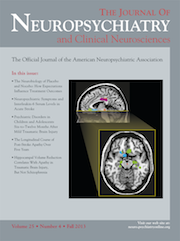Tourette Syndrome in a Patient With Resistance to Thyroid Hormone Syndrome
To the Editor: Resistance to thyroid hormone (RTH), first identified by Samuel Refetoff, is a syndrome with an estimated incidence of 1:40,000 live births, characterized by reduced end-organ responsiveness to thyroid hormones.1 RTH is most frequently caused by mutations involving the thyroid hormone receptor beta gene (THRB).2 The hormonal pattern is characterized by elevated serum free T4 (fT4) concentration, in association with nonsuppressed TSH, usually accompanied by high serum free T3 (fT3). Patients with RTH syndrome can present with considerable interindividual variations and heterogeneous phenotypes.2 The following symptoms and signs have consistently been associated with RTH: hyperactive behavior, speech impediment, developmental delay, learning disability, growth retardation, hearing loss, and sinus tachycardia.3
To the best of our knowledge, we identified the first case of genetically-ascertained RTH presenting with Tourette syndrome (TS) and comorbid attention-deficit hyperactivity disorder (ADHD). Our patient was vaginally delivered at 37 weeks of gestation, with appropriate weight and length for gestational age. He was born from unrelated parents. No enlargement of the thyroid gland was noted, and TSH levels were normal at newborn screening. During the first year of life, his weight and height were at the 3rd percentile for sex and age, 2 standard deviations below his target. At 6 months, he was referred to the Pediatric Endocrinology Unit to investigate his failure to thrive. His thyroid hormone profile showed normal TSH (1.58 μIU/ml; normal range: 0.5–4.2), with elevated fT3 (9.17 pg/ml; normal range: 2.6–5.8) and fT4 levels (2.28 ng/dl; normal range: 0.63–1.53). Antithyroglobulin, antithyroperoxidase, and anti-TSH antibodies were negative. Ultrasonographic examination showed no alteration of the thyroid gland. When he was 16 months old, he underwent bone age assessment, which showed a bone age of 9 months, according to Greulich and Pyle classification. We hypothesized RTH syndrome and carried out molecular analysis for THRB gene mutation, which revealed a mis-sense mutation in the heterozygous state, for GCC-to-ACC transition, resulting in Alanine-to-Threonine substitution at codon 234 (A234T).
At the age of 15, he underwent specialist assessment for possible TS for chronic tic symptoms. On neuropsychiatric assessment, he reported multiple motor tics (including facial grimacing and fidgeting) and phonic tics (mainly shouting and barking), which had been present since the age of 6. All tics were characteristically preceded by premonitory urges, and he was able to voluntarily suppress them at the expense of mounting inner tension. He scored 68% at the TS Diagnostic Confidence Index, which is in line with scores reported at specialist TS clinics, and 41% at the Yale Global Tic Severity Scale, indicating moderate tic severity. There was no evidence of comorbid psychiatric disorders, with the exception of mild ADHD and developmental dyslexia, in the absence of speech or cognitive impairment.
Our case report suggests that the behavioral phenotype of RTH should be extended to include tic disorders. Further research should ascertain whether the noted association between RTH and TS is mediated by the presence of ADHD, a condition characterized by high comorbidity rates with both RTH4 and TS.5
1 : The syndromes of resistance to thyroid hormone. Endocr Rev 1993; 14:348–399Medline, Google Scholar
2 : Generalized resistance to thyroid hormone associated with a mutation in the ligand-binding domain of the human thyroid hormone receptor beta. Proc Natl Acad Sci U S A 1989; 86:8977–8981Crossref, Medline, Google Scholar
3 :
4 : Attention-deficit hyperactivity disorder in people with generalized resistance to thyroid hormone. N Engl J Med 1993; 328:997–1001Crossref, Medline, Google Scholar
5 : The behavioral spectrum of Gilles de la Tourette syndrome. J Neuropsychiatry Clin Neurosci 2009; 21:13–23Link, Google Scholar



